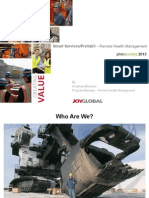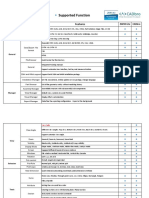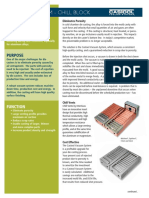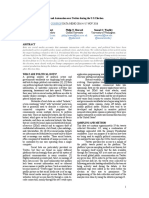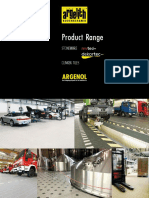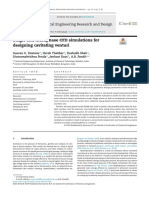Professional Documents
Culture Documents
E Logistic System
Copyright
Available Formats
Share this document
Did you find this document useful?
Is this content inappropriate?
Report this DocumentCopyright:
Available Formats
E Logistic System
Copyright:
Available Formats
Volume 3, Issue 2, February – 2018 International Journal of Innovative Science and Research Technology
ISSN No:-2456 –2165
E-Logistic System
Heena Mohd. Ashraf Gigani , Usman Gani M.H Kadariya , Imran Mukhtar Ahmed Shaikh , Mohid Mahmood Kazi ,
Prof. Javed Khan Sheikh
Department of Computer Engineering,
Anjuman-I-Islam’s Kalsekar Technical Campus University of Mumbai.
Abstract—In most of the cities, the transportation In this paper, we propose an online E-Logistic system, through
industry is highly regulated and utilizes the traditional which transportation of goods became straightforward, hassle
techniques. However, people faces many problems such as free and effortless for the user and for transportation
searching for the vehicle as per their requirement which management also. By this online system, a user can search for
results wastage of time as well as it is hectic. The purpose the vehicle as per their requirement and by entering source and
of our project is to build E-Logistics, an online system for destination they can view the estimated amount of time,
the customers where they can search for the appropriate distance and cost also. The main thing here is user can lively
vehicle and book them for their goods transportation with track their ride of goods. If the user is satisfied, then the ride is
live updates. The system will estimate the cost via instantly booked, an invoice is being generated and a
algorithm, the required amount of time between the source notification is being provoked to them. Driver picks up the
and destination is calculated using Algorithm, optimal goods from source location and dispatches them to the
route is selected and tracking of goods carrying vehicle is destination.
done through Google Map’s API. So through our system
customer can easily search for the vehicle within his/her II. OBJECTIVE AND SCOPE
nearby source location as per the requirement and can get
live updates that assures for delivery of goods. The purpose of our project is to build E-Logistics, an online
system for the customers where they can search for the
Keywords—Booking, Driver, E-Logistics, Google API, Live appropriate vehicle and book them for their goods
Tracking. transportation with live updates. The system will estimate the
cost, the required amount of time between the source and
I. INTRODUCTION destination is calculated, optimal route is selected and
tracking of goods carrying vehicle is done.
In traditional transportation approach, if a user wants to
transport the goods, he/she needs to go to the transport office
and has to enquire about the vehicle, cost. If he/she is satisfied It can be expanded further by building a Chabot for customer
with the amount of ride and vehicle, he has to do the payment. assistance which would be available 24*7.Android
Driver of transportation then picks up the good from source application can be built for more feasibility.
and delivers it to the destination within appropriate amount of
time. Here the user can’t track the good’s location as there is It can be made for inter cities transportation as of now it is
no online system or portal for it. All the drivers and user’s only intra city.People who wants to invest can put their new
information, goods record, vehicles record are not in a trucks in this system and can earn or have profit easily by
systematic manner nor a database is being managed. Even doing one time investment.
transportation done in a day or in a week or in a month can’t
be estimated efficiently. Increase in the employment of the truck drivers as they can
get more and more calls for the goods transportation.
So by considering all these stuffs and the hectic which the user
suffers from as well as the transportation management system,
it became mandatory that there should be an online system for
ease and proper management.
IJISRT18FB140 www.ijisrt.com 319
Volume 3, Issue 2, February – 2018 International Journal of Innovative Science and Research Technology
ISSN No:-2456 –2165
III. WORKING OF PROJECT estimated time for the vehicle to reach the source, once the
good is loaded and moves towards the destination, the user can
The user i.e customer signs-up in the system. After sign-in live track the movement of the vehicle. Once the vehicle
user inputs the source, destination and weight of the goods reaches the destination, the user can will have to pay charges
which is to be delivered. After submitting the values, user gets of the service online or by cash.
the estimated time, estimated cost, optimal path and vehicle
according to the weight for the delivery. Once user confirms IV. PROPOSED SYSTEM AND MODULES
the booking, driver is assigned to that particular us he gets the
A. System Architecture
Fig. 1: System Architecture
IJISRT18FB140 www.ijisrt.com 320
Volume 3, Issue 2, February – 2018 International Journal of Innovative Science and Research Technology
ISSN No:-2456 –2165
B. Modules system or can update the system. Whole the responsibilities of
the system is on the shoulder of admin.
a). Login
b). Booking
• User Login
User enters his credentials or registers himself if he is new to After entering source and destination and getting trip
the system. Once entered, he will be logged in to the system estimation if user wishes to book the vehicle then he confirms
and will be able to book transport vehicle. Without getting log the booking. As the trip is confirmed, the driver is assigned, he
in, no user can book the trip. After logging, user would be able takes the luggage from source and delivers it to mentioned
to book the trip. destination. All this booking information is stored in the
database. After booking, payment mode is being chosen by the
• Driver Login user. Invoice is being generated and Booking Id is assigned to
Driver logs in to the system with his driver id to get connected the user through which further he would be recognized.
with the system. If the driver ison duty, he has to logs in with
his driver’s id and can get out of the system by logging out. As c). Location Tracker
some user confirms the booking, particular driver is being
Tracking of goods carrying vehicle is done by the user using
assigned to them. Once the user is connected, he is available to
Google Map’s API. Through this, the best optimal route,
take the orders for deliveries.
distance, time is being calculated and live tracking of vehicle
• Admin Login is shown.
Admin will login to check the whole status of the system.
He/she can remotely access the system and can view the d). Driver
system. Assigns the duty or assigns the trip to the driver as the
After the confirmation of trip by the user, particular driver is
user books. Estimates the total cost for the day and can
being assigned to that user’s luggage. Driver takes the luggage
analyses his/her profit. After analyzing , can change the
from the source location and dispatches it to the destination.
on and dispatches it to the destination.
C. Diagram
Fig. 2 Use-case Diagram
IJISRT18FB140 www.ijisrt.com 321
Volume 3, Issue 2, February – 2018 International Journal of Innovative Science and Research Technology
ISSN No:-2456 –2165
V. CONCLUSION McLean, VA, Rep. FHWA-RD-98-057-2.
[13]. Deqi, H., Xiumin, C., &Zhe, M., (2012) A
So through our system, customer can easily search for the Simulation Framework for Emergency Response of
transport vehicle within his/hernearby source location, that Highway Traffic Accident. Procedia Engineering 29,
will save customer’s ample amount of time. Customer can 1075 – 1080.
search the vehicle by its size and capacity of goods, if
customer want to transport less goods then it will go for small
vehicle, its cost will be less then the big size vehicle which
ultimately saves money of customer. Also user can get live
updates about the vehicle, that assures safe delivery of goods.
REFERENCES
[1]. Bhupendra Singh1; Ankit Gupta2 (Apr. 2015) ‘Recent
Trends in intelligence transportation systems: a review’1
IIT Roorkee, Roorkee, Uttarakhand, India 2 IIT, BHU,
Varanasi, India
[2]. Judd Cramer Alan B. Krueger(March 2016)’Disruptive
change in the Taxi Business: The Case of Uber’ 1050
Massachusetts Avenue Cambridge, MA 02138.
[3]. Website: www.porter.in
[4]. Farber, Henry S. “Why You Can’t Find a Taxi in the Rain
and Other Labor Supply Lessons from Cab Drivers,” The
Quarterly Journal of Economics 130(4): 1781-1824, 2015.
[5]. Guillaume Frechette, Alessandro Lizzeri, and Tobias
Salz. “Frictions in a Competitive, Regulated Market:
Evidence from Taxis,” New York University, August 10,
2015. Available at
http://www.econ.nyu.edu/user/lizzeria/draft_071015.pdf
[6]. Jonathan Hall, and Alan Krueger. “An Analysis of the
Labor Market for Uber’s Driver-Partners in the United
States,” Princeton University Industrial Relations Section
Working Paper No. 587, January 2015.
[7]. Leah-Martin, Vincent. “When to Quit: Narrow Bracketing
and Reference Dependence in Taxi Drivers,” Working
Paper University of California San Diego, 2015.
[8]. Licensing on the Labor Market. Journal of Labor
Economics 31(Suppl. 1): S173-202, 2013.
[9]. Nelson/Nygaard (with Taxi Research Partners). “Taxi
Consultant Report,” City of Boston, October 11, 2013.
Available at
http://www.cityofboston.gov/mayor/pdfs/bostaxiconsultan
t.pdf
[10]. Soper, Taylor. “The Uber effect: Seattle taxi industry
revenue dipped 28% in past 2 years,” GeekWire, June 11,
2015. Available at http://www.geekwire.com/2015/the-
uber-effect-seattle-taxi-industry-revenue-dipped-28-in-
past-two-years/
[11]. Balaji, P. G., &Srinivasan D. (2011). Type-2 Fuzzy
Logic Based Urban Traffic Management. Engineering
Applications of Artificial Intelligence, 24, 12–22.
[12]. Campbell, J. L., Carney, C., &Kantowitz, B. H.
(2003). Human Factors Design Guidelines for Advanced
Traveler Information Systems (ATIS) and Commercial
Vehicle Operation (CVO).Federal Highway Admin.,
IJISRT18FB140 www.ijisrt.com 322
You might also like
- Automatic Power Factor ControllerDocument4 pagesAutomatic Power Factor ControllerInternational Journal of Innovative Science and Research TechnologyNo ratings yet
- Intelligent Engines: Revolutionizing Manufacturing and Supply Chains with AIDocument14 pagesIntelligent Engines: Revolutionizing Manufacturing and Supply Chains with AIInternational Journal of Innovative Science and Research TechnologyNo ratings yet
- Navigating Digitalization: AHP Insights for SMEs' Strategic TransformationDocument11 pagesNavigating Digitalization: AHP Insights for SMEs' Strategic TransformationInternational Journal of Innovative Science and Research TechnologyNo ratings yet
- A Review: Pink Eye Outbreak in IndiaDocument3 pagesA Review: Pink Eye Outbreak in IndiaInternational Journal of Innovative Science and Research TechnologyNo ratings yet
- Teachers' Perceptions about Distributed Leadership Practices in South Asia: A Case Study on Academic Activities in Government Colleges of BangladeshDocument7 pagesTeachers' Perceptions about Distributed Leadership Practices in South Asia: A Case Study on Academic Activities in Government Colleges of BangladeshInternational Journal of Innovative Science and Research TechnologyNo ratings yet
- Securing Document Exchange with Blockchain Technology: A New Paradigm for Information SharingDocument4 pagesSecuring Document Exchange with Blockchain Technology: A New Paradigm for Information SharingInternational Journal of Innovative Science and Research TechnologyNo ratings yet
- Mobile Distractions among Adolescents: Impact on Learning in the Aftermath of COVID-19 in IndiaDocument2 pagesMobile Distractions among Adolescents: Impact on Learning in the Aftermath of COVID-19 in IndiaInternational Journal of Innovative Science and Research TechnologyNo ratings yet
- Studying the Situation and Proposing Some Basic Solutions to Improve Psychological Harmony Between Managerial Staff and Students of Medical Universities in Hanoi AreaDocument5 pagesStudying the Situation and Proposing Some Basic Solutions to Improve Psychological Harmony Between Managerial Staff and Students of Medical Universities in Hanoi AreaInternational Journal of Innovative Science and Research TechnologyNo ratings yet
- Review of Biomechanics in Footwear Design and Development: An Exploration of Key Concepts and InnovationsDocument5 pagesReview of Biomechanics in Footwear Design and Development: An Exploration of Key Concepts and InnovationsInternational Journal of Innovative Science and Research TechnologyNo ratings yet
- Perceived Impact of Active Pedagogy in Medical Students' Learning at the Faculty of Medicine and Pharmacy of CasablancaDocument5 pagesPerceived Impact of Active Pedagogy in Medical Students' Learning at the Faculty of Medicine and Pharmacy of CasablancaInternational Journal of Innovative Science and Research TechnologyNo ratings yet
- Formation of New Technology in Automated Highway System in Peripheral HighwayDocument6 pagesFormation of New Technology in Automated Highway System in Peripheral HighwayInternational Journal of Innovative Science and Research TechnologyNo ratings yet
- Natural Peel-Off Mask Formulation and EvaluationDocument6 pagesNatural Peel-Off Mask Formulation and EvaluationInternational Journal of Innovative Science and Research TechnologyNo ratings yet
- Drug Dosage Control System Using Reinforcement LearningDocument8 pagesDrug Dosage Control System Using Reinforcement LearningInternational Journal of Innovative Science and Research TechnologyNo ratings yet
- The Effect of Time Variables as Predictors of Senior Secondary School Students' Mathematical Performance Department of Mathematics Education Freetown PolytechnicDocument7 pagesThe Effect of Time Variables as Predictors of Senior Secondary School Students' Mathematical Performance Department of Mathematics Education Freetown PolytechnicInternational Journal of Innovative Science and Research TechnologyNo ratings yet
- Enhancing the Strength of Concrete by Using Human Hairs as a FiberDocument3 pagesEnhancing the Strength of Concrete by Using Human Hairs as a FiberInternational Journal of Innovative Science and Research TechnologyNo ratings yet
- Supply Chain 5.0: A Comprehensive Literature Review on Implications, Applications and ChallengesDocument11 pagesSupply Chain 5.0: A Comprehensive Literature Review on Implications, Applications and ChallengesInternational Journal of Innovative Science and Research TechnologyNo ratings yet
- Advancing Opthalmic Diagnostics: U-Net for Retinal Blood Vessel SegmentationDocument8 pagesAdvancing Opthalmic Diagnostics: U-Net for Retinal Blood Vessel SegmentationInternational Journal of Innovative Science and Research TechnologyNo ratings yet
- The Making of Self-Disposing Contactless Motion-Activated Trash Bin Using Ultrasonic SensorsDocument7 pagesThe Making of Self-Disposing Contactless Motion-Activated Trash Bin Using Ultrasonic SensorsInternational Journal of Innovative Science and Research TechnologyNo ratings yet
- Placement Application for Department of Commerce with Computer Applications (Navigator)Document7 pagesPlacement Application for Department of Commerce with Computer Applications (Navigator)International Journal of Innovative Science and Research TechnologyNo ratings yet
- REDLINE– An Application on Blood ManagementDocument5 pagesREDLINE– An Application on Blood ManagementInternational Journal of Innovative Science and Research TechnologyNo ratings yet
- Beyond Shelters: A Gendered Approach to Disaster Preparedness and Resilience in Urban CentersDocument6 pagesBeyond Shelters: A Gendered Approach to Disaster Preparedness and Resilience in Urban CentersInternational Journal of Innovative Science and Research TechnologyNo ratings yet
- Exploring the Clinical Characteristics, Chromosomal Analysis, and Emotional and Social Considerations in Parents of Children with Down SyndromeDocument8 pagesExploring the Clinical Characteristics, Chromosomal Analysis, and Emotional and Social Considerations in Parents of Children with Down SyndromeInternational Journal of Innovative Science and Research TechnologyNo ratings yet
- Handling Disruptive Behaviors of Students in San Jose National High SchoolDocument5 pagesHandling Disruptive Behaviors of Students in San Jose National High SchoolInternational Journal of Innovative Science and Research TechnologyNo ratings yet
- Safety, Analgesic, and Anti-Inflammatory Effects of Aqueous and Methanolic Leaf Extracts of Hypericum revolutum subsp. kenienseDocument11 pagesSafety, Analgesic, and Anti-Inflammatory Effects of Aqueous and Methanolic Leaf Extracts of Hypericum revolutum subsp. kenienseInternational Journal of Innovative Science and Research TechnologyNo ratings yet
- A Curious Case of QuadriplegiaDocument4 pagesA Curious Case of QuadriplegiaInternational Journal of Innovative Science and Research TechnologyNo ratings yet
- A Knowledg Graph Model for e-GovernmentDocument5 pagesA Knowledg Graph Model for e-GovernmentInternational Journal of Innovative Science and Research TechnologyNo ratings yet
- Analysis of Financial Ratios that Relate to Market Value of Listed Companies that have Announced the Results of their Sustainable Stock Assessment, SET ESG Ratings 2023Document10 pagesAnalysis of Financial Ratios that Relate to Market Value of Listed Companies that have Announced the Results of their Sustainable Stock Assessment, SET ESG Ratings 2023International Journal of Innovative Science and Research TechnologyNo ratings yet
- Pdf to Voice by Using Deep LearningDocument5 pagesPdf to Voice by Using Deep LearningInternational Journal of Innovative Science and Research TechnologyNo ratings yet
- Adoption of International Public Sector Accounting Standards and Quality of Financial Reporting in National Government Agricultural Sector Entities, KenyaDocument12 pagesAdoption of International Public Sector Accounting Standards and Quality of Financial Reporting in National Government Agricultural Sector Entities, KenyaInternational Journal of Innovative Science and Research TechnologyNo ratings yet
- Fruit of the Pomegranate (Punica granatum) Plant: Nutrients, Phytochemical Composition and Antioxidant Activity of Fresh and Dried FruitsDocument6 pagesFruit of the Pomegranate (Punica granatum) Plant: Nutrients, Phytochemical Composition and Antioxidant Activity of Fresh and Dried FruitsInternational Journal of Innovative Science and Research TechnologyNo ratings yet
- Shoe Dog: A Memoir by the Creator of NikeFrom EverandShoe Dog: A Memoir by the Creator of NikeRating: 4.5 out of 5 stars4.5/5 (537)
- Grit: The Power of Passion and PerseveranceFrom EverandGrit: The Power of Passion and PerseveranceRating: 4 out of 5 stars4/5 (587)
- Hidden Figures: The American Dream and the Untold Story of the Black Women Mathematicians Who Helped Win the Space RaceFrom EverandHidden Figures: The American Dream and the Untold Story of the Black Women Mathematicians Who Helped Win the Space RaceRating: 4 out of 5 stars4/5 (890)
- The Yellow House: A Memoir (2019 National Book Award Winner)From EverandThe Yellow House: A Memoir (2019 National Book Award Winner)Rating: 4 out of 5 stars4/5 (98)
- The Little Book of Hygge: Danish Secrets to Happy LivingFrom EverandThe Little Book of Hygge: Danish Secrets to Happy LivingRating: 3.5 out of 5 stars3.5/5 (399)
- On Fire: The (Burning) Case for a Green New DealFrom EverandOn Fire: The (Burning) Case for a Green New DealRating: 4 out of 5 stars4/5 (73)
- The Subtle Art of Not Giving a F*ck: A Counterintuitive Approach to Living a Good LifeFrom EverandThe Subtle Art of Not Giving a F*ck: A Counterintuitive Approach to Living a Good LifeRating: 4 out of 5 stars4/5 (5794)
- Never Split the Difference: Negotiating As If Your Life Depended On ItFrom EverandNever Split the Difference: Negotiating As If Your Life Depended On ItRating: 4.5 out of 5 stars4.5/5 (838)
- Elon Musk: Tesla, SpaceX, and the Quest for a Fantastic FutureFrom EverandElon Musk: Tesla, SpaceX, and the Quest for a Fantastic FutureRating: 4.5 out of 5 stars4.5/5 (474)
- A Heartbreaking Work Of Staggering Genius: A Memoir Based on a True StoryFrom EverandA Heartbreaking Work Of Staggering Genius: A Memoir Based on a True StoryRating: 3.5 out of 5 stars3.5/5 (231)
- The Emperor of All Maladies: A Biography of CancerFrom EverandThe Emperor of All Maladies: A Biography of CancerRating: 4.5 out of 5 stars4.5/5 (271)
- The Gifts of Imperfection: Let Go of Who You Think You're Supposed to Be and Embrace Who You AreFrom EverandThe Gifts of Imperfection: Let Go of Who You Think You're Supposed to Be and Embrace Who You AreRating: 4 out of 5 stars4/5 (1090)
- The World Is Flat 3.0: A Brief History of the Twenty-first CenturyFrom EverandThe World Is Flat 3.0: A Brief History of the Twenty-first CenturyRating: 3.5 out of 5 stars3.5/5 (2219)
- Team of Rivals: The Political Genius of Abraham LincolnFrom EverandTeam of Rivals: The Political Genius of Abraham LincolnRating: 4.5 out of 5 stars4.5/5 (234)
- The Hard Thing About Hard Things: Building a Business When There Are No Easy AnswersFrom EverandThe Hard Thing About Hard Things: Building a Business When There Are No Easy AnswersRating: 4.5 out of 5 stars4.5/5 (344)
- Devil in the Grove: Thurgood Marshall, the Groveland Boys, and the Dawn of a New AmericaFrom EverandDevil in the Grove: Thurgood Marshall, the Groveland Boys, and the Dawn of a New AmericaRating: 4.5 out of 5 stars4.5/5 (265)
- The Unwinding: An Inner History of the New AmericaFrom EverandThe Unwinding: An Inner History of the New AmericaRating: 4 out of 5 stars4/5 (45)
- The Sympathizer: A Novel (Pulitzer Prize for Fiction)From EverandThe Sympathizer: A Novel (Pulitzer Prize for Fiction)Rating: 4.5 out of 5 stars4.5/5 (119)
- Her Body and Other Parties: StoriesFrom EverandHer Body and Other Parties: StoriesRating: 4 out of 5 stars4/5 (821)
- SSP 099 18 Tfsi 132kw 20 Tfsi 162kw Ea888Document60 pagesSSP 099 18 Tfsi 132kw 20 Tfsi 162kw Ea888Jose Ramón Orenes ClementeNo ratings yet
- Joy Global SolutionsDocument18 pagesJoy Global Solutionsjvr001100% (1)
- As 2560.2.1-2003 Sports Lighting Specific Applications - Lighting For Outdoor TennisDocument7 pagesAs 2560.2.1-2003 Sports Lighting Specific Applications - Lighting For Outdoor TennisSAI Global - APAC0% (1)
- Zw3d2022 Lite Vs Cadbro 2022Document4 pagesZw3d2022 Lite Vs Cadbro 2022Carlos LimaNo ratings yet
- Float Trap PennantDocument2 pagesFloat Trap PennantJinalkumarNo ratings yet
- Vacuum Chill BlockDocument2 pagesVacuum Chill BlockAditheya Varthan MNo ratings yet
- Genesis of Spalling in Tandem Mill Work-RollsDocument9 pagesGenesis of Spalling in Tandem Mill Work-Rolls54321qazNo ratings yet
- Extent, Yield, and SelectivityDocument10 pagesExtent, Yield, and SelectivityKristopher Ray Simbulan PamintuanNo ratings yet
- PactFocus Report - Sample - LPGDocument27 pagesPactFocus Report - Sample - LPGIqbal HussainNo ratings yet
- NPN Silicon Transistor: High Voltage Switch Mode ApplicationDocument6 pagesNPN Silicon Transistor: High Voltage Switch Mode ApplicationManuel PradoNo ratings yet
- Bots and Automation Over Twitter During The U.S. Election: CompropDocument5 pagesBots and Automation Over Twitter During The U.S. Election: CompropRaninha MoraisNo ratings yet
- Psib 20150212Document10 pagesPsib 20150212Léandre Ettekri NdriNo ratings yet
- Pure Chem p2 - 26pgDocument26 pagesPure Chem p2 - 26pgJhomer CrespoNo ratings yet
- Datasheet SharePlexDocument2 pagesDatasheet SharePlexBruno PóvoaNo ratings yet
- Argelith Lieferprogramm GBDocument24 pagesArgelith Lieferprogramm GBmutyokaNo ratings yet
- Dedi Kristiawan: Personal DetailDocument5 pagesDedi Kristiawan: Personal DetaildedyNo ratings yet
- RT 50Document2 pagesRT 50valentin prouteauNo ratings yet
- Corrosion in Oil and Gas Industry A Perspective On Corrosion InhibitorsDocument1 pageCorrosion in Oil and Gas Industry A Perspective On Corrosion InhibitorsAsma Sed100% (1)
- Appendix 400.4 - Traffic Count TemplateDocument7 pagesAppendix 400.4 - Traffic Count TemplateOgunranti RasaqNo ratings yet
- Fleet ManagementDocument8 pagesFleet ManagementDiana LorenaNo ratings yet
- (Mamoru Hosaka (Auth.) ) Modeling of Curves and SuDocument363 pages(Mamoru Hosaka (Auth.) ) Modeling of Curves and Suamalendu_biswas_1No ratings yet
- Sant Gadge Baba Amravati University: Backlog From Session Winter-2019Document2 pagesSant Gadge Baba Amravati University: Backlog From Session Winter-2019Prashant pandeNo ratings yet
- Fontaine Quinta RuedaDocument2 pagesFontaine Quinta RuedaHamilton MirandaNo ratings yet
- G.25-GEMSS-G-02 Rev 01plant Design CriteriaDocument13 pagesG.25-GEMSS-G-02 Rev 01plant Design Criteriamohammad kassarNo ratings yet
- Twice As Sharp Operators ManualDocument34 pagesTwice As Sharp Operators ManualLeonardo CHTZNo ratings yet
- Engineering Structures: SciencedirectDocument8 pagesEngineering Structures: SciencedirectFeleki AttilaNo ratings yet
- Theory of Metal Cutting-Module 1Document116 pagesTheory of Metal Cutting-Module 1rejeesh_rajendranNo ratings yet
- Single and Multiphase CFD Simulations For Designing Cavitating VenturiDocument12 pagesSingle and Multiphase CFD Simulations For Designing Cavitating VenturiCarlos GamarraNo ratings yet
- PRJCTDocument10 pagesPRJCTrpkn541No ratings yet
- Electricity Scavenger HuntDocument1 pageElectricity Scavenger HuntksonicoNo ratings yet








































































